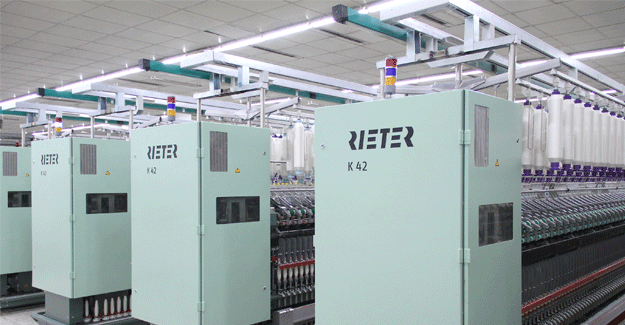K 42 Achieving Top Speeds With Good Yarn Quality Debut In China
K 42 Achieving Top Speeds With Good Yarn Quality Debut In China

Customers in China requested for the Rieter compact-spinning machine K 42 to run at slower speeds than it does in other countries. They were worried that high spinning speeds would lead to higher ends down rates, and therefore a rise in wage costs. Rieter conducted trials at a Chinese customer to prove that the K 42 is a master at balancing high speeds and low ends down rates.
Spinning mills can successfully sell their yarn only when the quality is right and the production costs are low. With this in mind, Rieter sees its task as developing machinery that will allow spinning mills to cut their costs. Production speed plays a key role in this regard. Increasing the speed boosts overall production, which results in a reduction in yarn production costs. Using high-performance machines is therefore key to any spinning mill being profitable.
Ruling out all risks
The compact-spinning machine K 42 (Fig. 1) runs at lower speeds in China than in other countries. In India, for example, weaving yarns of pure cotton in Ne 60 and Ne 80 yarn counts are run at speeds of up to 25 000 rpm (for Ne 60) or 23 000 rpm (for Ne 80). The same yarn counts are run at a maximum speed of just 18 500 rpm in China.
Chinese customers do not operate their machines at higher speeds because this could lead to higher ends down rates. If the accepted maximum of 15 ends down per 1 000 spindle hours were to be exceeded, it would bring about an increased risk of higher wage costs. There is also an assumption that higher speeds will result in lower yarn quality, in terms of hairiness in particular. Chinese customers therefore want to ensure that their machines work soundly and deliver good quality, which is a perfectly normal requirement. However, this does mean that they are missing out on the chance of high productivity. Trials conducted at a Chinese customer are set to disprove the widespread concerns of spinning speeds being too high.
30% more yarn with the same quality
In a joint project with a Chinese customer, Rieter took the opportunity to increase the speed of the current compact -spinning machines K 42. Additional parameters such as yarn count and elongation, as well as technology components remained unchanged. For instance, the original spinning speed of 16 500 rpm was increased incrementally to 21?500 rpm for a weaving yarn of Ne 60. The result was a rise in productivity by 30.3% and a consistently good yarn quality.
For one weaving yarn of count Ne 80, the speed was increased from 18 500 rpm to 20 500 rpm, resulting in a 10% rise in production. Although the yarn quality was slightly worse, it still met the customer's requirements.
Ends down and hairiness also at a good level
When increases are made to the spinning speed, Chinese customers focus, in particular, on the ends down and hairiness of the yarn. Both aspects were tested with every incremental increase. Even when run at higher speeds, the ends down rate fell below the maximum permitted ends down of 15 per 1 000 spindle hours, while the hairiness remained virtually unchanged.
The trial results therefore clearly showed the concerns of Chinese customers regarding maximum production with the K 42 to be unfounded. Key requirements included the precise centering of components such as the yarn guide, balloon control ring and spinning ring as well as an incremental increase in speed.
Impressive figures
A 30% increase in speeds provides a 14% decrease in yarn production costs. For example, in a project involving compact-spinning machines K 42 with a total of 50 000 spindles, the customer could achieve an annual increase in profits of CHF 750 000 (based on running 350 days, 24 hours a day).
Decisive factors
Spinning mills that use Rieter compact-spinning machines can therefore run at high speeds. And with good yarn quality. This is made possible by the unique spinning geometry. A systematic approach is required to utilize the potential of the K 42 in full. In doing so, factors such as raw material and technology components must be considered, as well as machine settings and climate control. In comparison to competitor machines, the K 42 can spin affordable yarns at a good level of quality, enabling all Rieter customers to assert themselves strongly in a hard-fought market.



 textileexcellence
textileexcellence 







